Roger Locher
| Roger Clinton Locher[1] | |
|---|---|
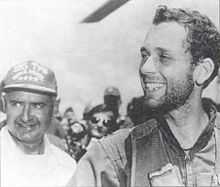 General John Vogt (L) with Capt Roger Locher on his return to Udorn Royal Thai Air Force Base | |
| Born |
September 13, 1946 Sabetha, Kansas[2] |
| Allegiance |
|
| Service/branch | United States Air Force |
| Rank | Captain |
| Battles/wars | Vietnam War |

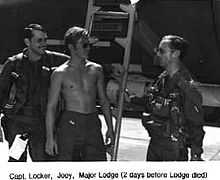
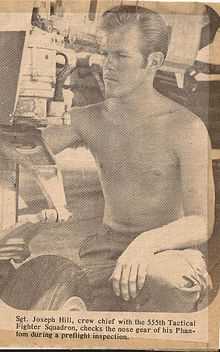
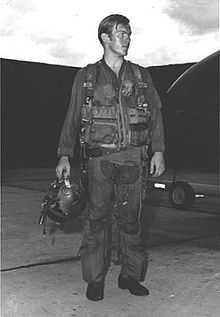

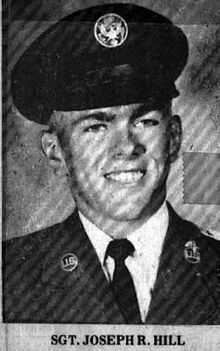
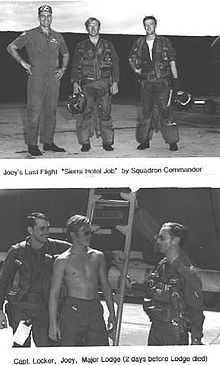

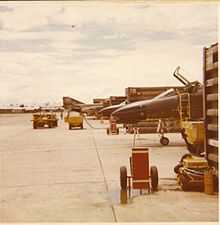
_432TRW_555TFS.jpg)
_475TFW_391TFS.jpg)
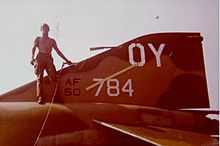


When his aircraft, Crew Chief Sgt. Joey Hill, F-4D 650784, was shot down by a Shenyang J-6 on May 10, 1972, Locher was on his third combat tour and had over 407 combat missions.[6][7] He was one of the leading MIG killers in Vietnam with three kills. No one saw him eject or his parachute open, and it was unknown whether he had died or been captured. Over the next two weeks, U.S. air crews in the area tried to raise him on the radio without success. The North Vietnamese did not add his name to the roster of captured airmen, which gave the Americans some hope. Traveling only at dusk and dawn, over three weeks Locher traveled about 12 miles (19 km), evading farmers and living off the land.
On June 1, Locher was finally able to successfully contact a flight of F-4 aircraft overhead. General John Vogt, commanding general of the Seventh Air Force, committed to rescue him and canceled the scheduled attack on Hanoi, diverting all of the available aircraft to assist in his rescue.[5] Despite the proximity of the Yên Bái MiG airfield only 5 miles (8.0 km) away and its well-developed anti-aircraft defenses, there were no losses during his rescue.
Recruitment and training
Locher attended Kansas State University, where he participated in ROTC, and then joined the Air Force in 1969. He completed navigator training and was assigned to the F-4 Phantom II. He received transition training at Davis–Monthan Air Force Base in Arizona, and was then sent to the "Triple Nickel" 555th Tactical Fighter Squadron, 432d Tactical Reconnaissance Wing, Udorn, Thailand.[8]
MiGCAP patrol
On February 21, 1972, Locher took part in the first U.S. Air Force aerial victory in four years at night over northeast Laos, about 90 miles (140 km) southwest of Hanoi. Maj. Robert A. Lodge was pilot and Locher was the weapon systems officer in an F-4D flying combat air patrol to interdict North Vietnamese MiGs (MIGCAP). The two men were the most experienced crew in Southeast Asia.[9] Red Crown, the call sign for the radar-equipped USS Long Beach stationed in the northern part of the Gulf of Tonkin, "called out bandits (MIGs) at our 060° position and proceeded to vector us on an intercept,” recalls Maj. Lodge. During the air battle, they shot down a MiG-21.[10]
Operation Linebacker

On May 8, 1972, Major Robert Lodge and Captain Locher responded to a request for assistance from Red Crown from fighters who were engaging MiGs near Yên Bái. Their element leader was Stephen Ritchie and Charles B. DeBellevue in Oyster 03.
We were about Mach 1.4, with the MIG about as fast as us in afterburner. I was low on the MIG, and I do not believe he was aware he was under attack. He was in a right turn, initially, then reversed to the left. I fired two AIM-7 missiles in ripple fire[notes 1] at a distance of 4,500 feet, using a pure pursuit attack at about 20 degrees angle-off. Both missiles guided directly to the target. The first hit the MIG’s right wing, which was breaking up when the second missile hit the center of the fuselage.
They scored their third MiG kill, placing them in the lead of all USAF crews then flying in Southeast Asia.
Two days later, on May 10, at 9:23 a.m., Oyster Flight was warned by EC-121 Disco over Laos, and then by the US Navy radar picket ship USS Chicago Red Crown, of four MiGs headed towards them. These were from the 921st Fighter Wing. Four J-9s were also flying CAP to protect the Thac Ba hydroelectric power station.[11]:59 The Americans engaged an equal number of MiG-21s head-on, scattering them. Lodge and Locher identified two hostile contacts 50 miles (80 km) miles south of Yên Bái. They attacked in a modified fluid-four formation and accelerated to 1.4 mach. At 9:48 they fired two AIM-7 missiles, and the second destroyed one of the MiGs.
Oyster Flight shot down two more MiGs. The second MIG-21 was downed by Lodge’s wingman, 1st Lt. John D. Markle, and his WSO, Capt. Stephen D. Eaves. A few minutes later Capt. Richard S. “Steve” Ritchie and Capt. Charles B. DeBellevue, his weapon systems officer, shot down a third MiG. Lodge and Locher nearly got the fourth MiG-21, but fell victim to a MiG tactic dubbed "Kuban tactics" after those of the Soviet WWII ace Alexander Pokryshkin,[12] in which a GCI-controlled flight of four Shenyang J-6s were launched after the MiG-21s so that they could be steered behind the American fighters maneuvering to attack the MiG-21s. Pilot Nguyen Manh Tung of No. 2 Flight[11] came up from below in his J-6 and hit Lodge and Locher's F-4D Phantom, serial 65-0784, with his three large, 30-mm cannons as they were lining up a second shot on another MiG-21.[13]
Ejection and evasion

Lodge reported later that the aircraft went into a kind of right slice. He noted that the right engine's RPM was at zero and the left was decreasing towards idle. It looked to him that the right engine had exploded. Lodge and his WSO discussed their options. They saw that the hydraulic pressure was low and falling. When Lodge tried the autopilot, it didn't respond. The rear of the jet was on fire, and as the plane yawed the slipstream pushed the flames up over Locher's canopy. Locher later recalled, "We immediately went out of control, flopping from side to side. Then fire started coming in the back of the cockpit. It seared my canopy with bubbles and I couldn't see out any more. The airplane slowed down and was approaching a flat spin." Passing through 8000 MSL, Locher told Lodge that it was getting too hot and he'd better get out. Lodge looked over his right shoulder at Locher and said, "Well, why don't you eject then?"[14]
Lodge had about three weeks previously told fellow squadron members, as he had done several times before, that he would not allow himself to be captured because of his extensive knowledge of classified and sensitive information.[15] Locher successfully ejected at about 8,000 feet (2,400 m) but because the remaining planes were busy with the other MiGs, and due to smoke, no one saw his parachute canopy.[4] Two Mig 19s (quite likely the ones that had just shot them down) buzzed Locher as he descended, so he knew the enemy was aware he had survived.[14] He estimated it took about 30 seconds for the jet to impact the ground, but never saw Lodge's chute.[14]
Locher was afraid to use his URC-64 rescue radio as he parachuted because it was difficult to remove from the zippered pocket of his survival vest and he was not sure he could get it back in. He figured out his rough location and managed to steer his chute about 2,000 yards (1,800 m) away from the plane burning below him and towards a nearby mountain side.[14] After he landed, he couldn't hide his parachute because it was stuck in the trees overhead.
He removed a couple of essential items from his survival pack and left the remainder behind. His survival vest contained a pistol, two pints of water, a first aid kit, insect repellent, mosquito netting, and a knife. He knew from prior briefings that he could not expect SAR this deep in North Vietnam, north of the Red River. Once on the ground and under the trees, he could not hear any jets overhead. He also knew his radio could not penetrate the dense jungle canopy overhead.[14]
Locher listened to hear if a search party was looking for him. He camouflaged his trail for about 100 yards (91 m) and then climbed the eastern side of the mountain to its peak. He got his bearings and then hid in bushes on the west slope. For three days, Locher listened as a search party of local farmers beat the bushes up and down the east side of the mountain, searching for him. He hid in a brush pile and at one point over the next three days, a boy came within 30 feet (9.1 m) of his hiding place.[4][14] In the evening he returned to the peak. On the second day he picked up radio traffic from American aircraft almost 100 miles (160 km) to his south, but they did not hear his radio beeper or voice.[16]
He decided his best chance for rescue was to cross the forested, hilly terrain and get to the heavily cultivated Red River Valley, swim the river, and work his way to the sparsely inhabited mountains to the south. He figured it would take him 45 days. He traveled only at first light and at dusk, avoiding the local farmers, and living off the land.[4][16]
He was able to find plenty of water but only occasionally fruit and berries to eat. He evaded capture and covered over 19 km (12 mi), gradually losing 30 pounds (14 kg) and his strength.[8] On the 10th day he came within 5 feet (1.5 m) of being discovered. Following a well-used trail early one morning, he suddenly had to evade local farmers. He hid in a nearby field where there was little concealment, but pulled leaves and debris over himself. He lay there all day as children from a village he discovered a short distance away played in his vicinity. At one point a water buffalo nearly stepped on him, and a boy came to fetch the animal, only a few feet from Locher. That evening he spotted a hill near the village alongside the Red River, the last hill before the wide open fields of the Red River basin. He was about 5 miles (8.0 km) from Yên Bái Airfield.[16]
He hid on the hill for the next 13 days and watched for American aircraft. On June 1, 1972, he was finally able to contact a flight of American jets overhead, calling, "Any U.S. aircraft, if you read Oyster 1 Bravo, come up on Guard".[17] R. Stephen Ritchie, in one of the F-4 aircraft overhead and who had witnessed Locher's jet fall out of the sky, remembered Locher's call sign and answered his call. Locher calmly responded, "Guys I've been down here a long time, any chance of picking me up?"[6] Ritchie replied, "You bet!" Locher's transmissions left some Americans who did not hear his call in doubt about the authenticity of his message, and they believed that the NVA may have manipulated a POW into impersonating him, setting a trap for the would-be rescuers.[4]
Search and rescue
A SAR mission of several A-1E and two HH-53 with F-4 and F- 105 fighters providing air protection was launched that same day but was driven off by heavy anti-aircraft fire and MiGs.[4][7] The A-1 Skyraider and HH-53C pilots came under attack from a MiG but eluded the enemy fighter in a narrow canyon. The rescue force then dodged missiles, another MiG and gunfire, but failed to get through to Locher that day.[18]
On June 2, 1972, General John Vogt, commander of the 7th Air Force, consulted with Army MACV commander General Frederick C. Weyand. Vogt canceled the entire strike mission set for Hanoi that day. He dedicated all the available resources, over 150 aircraft, to rescuing Locher.[6] The direct task force of 119 aircraft[18] included two HH-53 rescue helicopters, bombers, and an array of F-4 escorts, EB-66s, A-1Es, F105G Weasels, and KC135 tankers.[19] Vogt said,
I had to decide whether we should risk the loss of maybe a dozen airplanes and crews just to get one man out. Finally I said to myself, Goddamn it, the one thing that keeps our boys motivated is the certain belief that if they go down, we will do absolutely everything we can to get them out. If that is ever in doubt, morale would tumble. That was my major consideration. So I took it on myself. I didn't ask anybody for permission. I just said, "Go do it!"[20]:30
The Yên Bái MiG airfield,[19] about 60 miles (97 km) northwest of Hanoi, was one of the most important and well-defended Vietnamese People's Air Force airbases in North Vietnam. The aircraft bombed and strafed around Yên Bái airfield for two hours, reducing enemy opposition so that the helicopters could get in. Fortunately for the Americans, during the second half of May 1972 their increasingly fierce attacks on Yen Bai had forced elements of the VPAF 925th Fighter Regiment to relocate to Gia Lam Airfield.[11] Capt. Ronald E. Smith in an A-1E guided Capt. Dale Stovall, piloting a HH-53 from the 40th Aerospace Rescue and Recovery Squadron, to Locher's position. Only when Locher rose out of the jungle canopy riding the jungle penetrator were all of the Americans sure it was him. Despite their proximity to Yen Bai airfield, no aircraft were lost during Locher's rescue.[5] "We shut down the war to go get Roger Locher," Stovall later said.[18]
Locher was flown back to Udorn. The first person to greet him was General Vogt, who had flown up from Saigon in a T-39.[5] Capt. Locher had successfully evaded capture for 23 days, a record for the Vietnam War.[4] The evening of his return, he was greeted at the Officers Club by hundreds of individuals with an ovation lasting 20 minutes.[5]
Recognition
Capt. Stovall had twice flown his HH-53 Jolly Green Giant helicopter further into North Vietnam than had ever been done before. For their efforts in rescuing Locher, both Capt. Ronald Smith and Stovall were awarded the Air Force Cross. Stovall's citation described how "he willingly returned to this high threat area, braving intense ground fire, to recover the downed airman from deep in North Vietnam.".[21] Stovall was also recognized with the 1973 Jabara Award for Airmanship.
Post war
After Roger returned to the States, he attended pilot training and was assigned to the Phantom—this time in the front seat. Roger flew the F-4 in New Mexico, Alaska, and Florida before transitioning to the F-16 and serving in instructor and flight commander positions.[8] He later played a key role in the early days of the super-secret "black program" that produced the Lockheed F-117 Nighthawk stealth fighter.[22] He retired in Sabetha, Kansas, where he resided as of April, 2010.[18][23]
In popular culture
The TV series Dogfights on the History Channel depicted the dogfight of May 10, 1972 in Season 2, Episode 10, The Bloodiest Day shown on December 3, 2007.
Notes
- ↑ "Ripple fire" means to have more than one missile in the air at one time. This cuts down the time it takes to engage and destroy a number of targets.
References
- ↑ "Search results for Roger Clinton Locher in Kansas". Intelius. Retrieved 2011-04-19.
- ↑ Hunter Keeter (January 2005). American Air Forces in the Vietnam War. Gareth Stevens. pp. 18–. ISBN 978-0-8368-5773-3. Retrieved 17 April 2011.
- ↑ "You searched: Roger C Locher 19460913". Public Background Checks. Retrieved 2011-04-10.
- ↑ 4.0 4.1 4.2 4.3 4.4 4.5 4.6 Frisbee, John L. (March 1992). Valor: A Good Thought to Sleep On 75 (3). AirforceMagazine.com. Retrieved April 6, 2011.
- ↑ 5.0 5.1 5.2 5.3 5.4 Steve Ritchie (Mar 24, 2011). Brig. Gen. Steve Ritchie and the Rescue of Roger Locher (video). Eustis, Florida. Retrieved April 7, 2011.
- ↑ 6.0 6.1 6.2 Maurice, Lindsey (March 9, 2010). "'Legends of Aerospace' Visit 'The Rock'". 386th Air Expeditionary Wing Public Affairs. Retrieved April 7, 2011.
- ↑ 7.0 7.1 LaPointe, Robert L. "1972". Vietnam History. Retrieved 19 April 2011.
- ↑ 8.0 8.1 8.2 "Eagle Biography Roger C. Locher". Montgomery, Alabama: Air University, Maxwell-Gunter Air Force Base. Retrieved April 7, 2011.
- ↑ Ron Steinman (2000). The soldiers' story: Vietnam in their own words. Barnes & Noble Publishing. pp. 279–. ISBN 978-0-7607-3262-5. Retrieved 17 April 2011.
- ↑ "Combat Narratives 1972–1973". Office of Air Force History and The Albert F. Simpson Historical Research Center. 1976. U.S. GPO Stock Number 008-070-00365. Retrieved April 7, 2011.
- ↑ 11.0 11.1 11.2 Toperczer, Istvcm (2001). "MiG-17 and MiG-19 Units of the Vietnam War". Osprey Combat Aircraft (Botley, Oxford, England: Osprey Publishing Ltd). ISBN 1-84176-162-1.
- ↑ Michel, Marshall L. (1997). Clashes: Air Combat Over North Vietnam 1965–1972. Naval Institute Press. p. 237. ISBN 1-55750-585-3.
- ↑ Cooper, Tom (Nov 13, 2003). "10 May 1972: Reconstruction of an Air Battle". Retrieved April 7, 2011.
- ↑ 14.0 14.1 14.2 14.3 14.4 14.5 John Locher. John Locher Survival Briefing, pt. 1. Retrieved April 7, 2011.
- ↑ Freeze, Di (May 2002). "Steve Ritchie—The Last Ace". Airport Journals. Retrieved April 7, 2011.
- ↑ 16.0 16.1 16.2 John Locher. John Locher Survival Briefing, pt. 2. Retrieved April 7, 2011.
- ↑ Hannah, Craig C. Striving for Air Superiority: the Tactical Air Command in Vietnam. p. 3. Retrieved 2011-04-19.
- ↑ 18.0 18.1 18.2 18.3 Dorr, Robert F. (March 1, 2004). "History in Blue". Air Force Times. Retrieved April 10, 2011.
- ↑ 19.0 19.1 "Lodge, Robert Alfred". PowNetwork. Retrieved April 6, 2011.
- ↑ Busboom, Lt. Col. Stanley (April 2, 1990). Bat 21: A Case Study. Carlisle Barracks, Pennsylvania: U.S. Army War College. Retrieved April 3, 2011.
- ↑ "Capt. Dale Stovall, Air Force Cross". Military Times. Retrieved April 7, 2011.
- ↑ Robert F. Dorr (5 July 2005). Chopper: firsthand accounts of helicopter warfare, World War II to Iraq. Berkley Books. ISBN 978-0-425-20273-9. Retrieved 17 April 2011.
- ↑ "Roger Locher in ZabaSearch People Search Engine". Retrieved April 10, 2010.